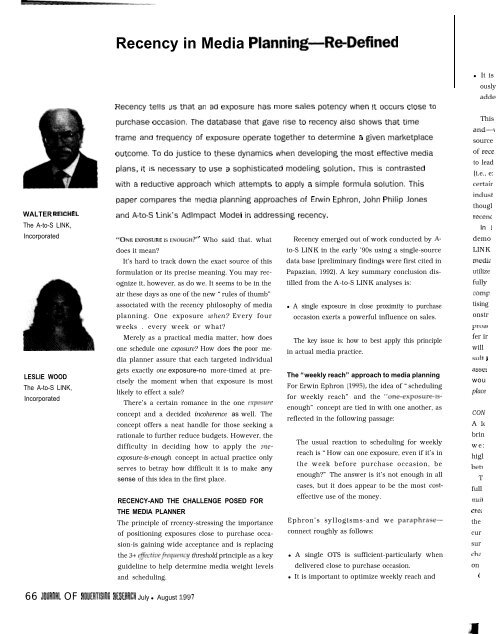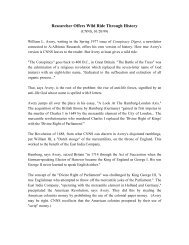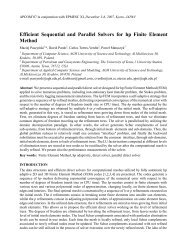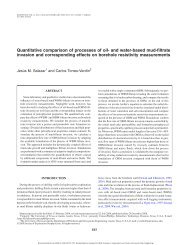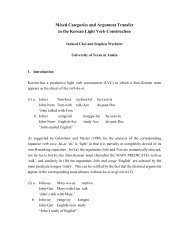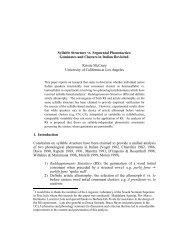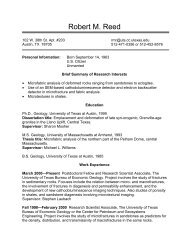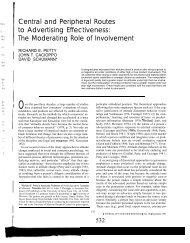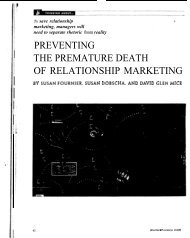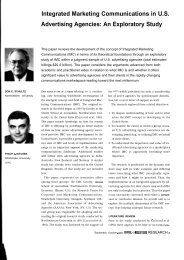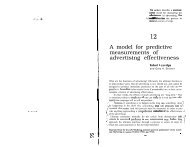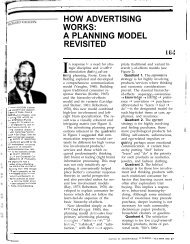Create successful ePaper yourself
Turn your PDF publications into a flip-book with our unique Google optimized e-Paper software.
WALTER REICHEL<br />
The A-to-S LINK,<br />
Incorporated<br />
LESLIE WOOD<br />
The A-to-S LINK,<br />
Incorporated<br />
<strong><strong>Re</strong>cency</strong> <strong>in</strong> <strong>Media</strong> Plann<strong>in</strong>g-<strong>Re</strong>-Def<strong>in</strong>ed<br />
<strong><strong>Re</strong>cency</strong> tells us that an ad exposure has more sales potency when it occurs close to<br />
purchase occasion. The database that gave rise to recency also shows that time<br />
frame and frequency of exposure operate together to determ<strong>in</strong>e a given marketplace<br />
outcome. To do justice to these dynamics when develop<strong>in</strong>g the most effective media<br />
plans, it is necessary to use a sophisticated model<strong>in</strong>g solution. This is contrasted<br />
with a reductive approach which attempts to apply a simple formula solution. This<br />
paper compares the media plann<strong>in</strong>g approaches of Erw<strong>in</strong> Ephron, John Philip Jones<br />
and A-to-S L<strong>in</strong>k’s Adlmpact Model <strong>in</strong> address<strong>in</strong>g recency.<br />
“ONE EXPOSURE IS ENOUGH?” Who said that. what<br />
does it mean?<br />
It’s hard to track down the exact source of this<br />
formulation or its precise mean<strong>in</strong>g. You may rec-<br />
ognize it, however, as do we. It seems to be <strong>in</strong> the<br />
air these days as one of the new “rules of thumb”<br />
associated with the recency philosophy of media<br />
plann<strong>in</strong>g. One exposure when? Every four<br />
weeks . every week or what?<br />
Merely as a practical media matter, how does<br />
one schedule one exposure? How does the poor me-<br />
dia planner assure that each targeted <strong>in</strong>dividual<br />
gets exactly one exposure-no more-timed at pre-<br />
cisely the moment when that exposure is most<br />
likely to effect a sale?<br />
There’s a certa<strong>in</strong> romance <strong>in</strong> the one exposure<br />
concept and a decided <strong>in</strong>coherence as well. The<br />
concept offers a neat handle for those seek<strong>in</strong>g a<br />
rationale to further reduce budgets. However, the<br />
difficulty <strong>in</strong> decid<strong>in</strong>g how to apply the one-<br />
exposure-is-enough concept <strong>in</strong> actual practice only<br />
serves to betray how difficult it is to make any<br />
sense of this idea <strong>in</strong> the first place.<br />
RECENCY-AND THE CHALLENGE POSED FOR<br />
THE MEDIA PLANNER<br />
The pr<strong>in</strong>ciple of rrcency-stress<strong>in</strong>g the importance<br />
of position<strong>in</strong>g exposures close to purchase occa-<br />
sion-is ga<strong>in</strong><strong>in</strong>g wide acceptance and is replac<strong>in</strong>g<br />
the 3+ effectivefrequency threshold pr<strong>in</strong>ciple as a key<br />
guidel<strong>in</strong>e to help determ<strong>in</strong>e media weight levels<br />
and schedul<strong>in</strong>g.<br />
66 JOURRRL OF RIIUERTISIRG RESERRCH July � August 1997<br />
<strong><strong>Re</strong>cency</strong> emerged out of work conducted by A-<br />
to-S LINK <strong>in</strong> the early ’90s us<strong>in</strong>g a s<strong>in</strong>gle-source<br />
data base (prelim<strong>in</strong>ary f<strong>in</strong>d<strong>in</strong>gs were first cited <strong>in</strong><br />
Papazian, 1992). A key summary conclusion dis-<br />
tilled from the A-to-S LINK analyses is:<br />
� A s<strong>in</strong>gle exposure <strong>in</strong> close proximity to purchase<br />
occasion exerts a powerful <strong>in</strong>fluence on sales.<br />
The key issue is: how to best apply this pr<strong>in</strong>ciple<br />
<strong>in</strong> actual media practice.<br />
The “weekly reach” approach to media plann<strong>in</strong>g<br />
For Erw<strong>in</strong> Ephron (1995), the idea of “schedul<strong>in</strong>g<br />
for weekly reach” and the “one-exposure-is-<br />
enough” concept are tied <strong>in</strong> with one another, as<br />
reflected <strong>in</strong> the follow<strong>in</strong>g passage:<br />
The usual reaction to schedul<strong>in</strong>g for weekly<br />
reach is “How can one exposure, even if it’s <strong>in</strong><br />
the week before purchase occasion, be<br />
enough?” The answer is it’s not enough <strong>in</strong> all<br />
cases, but it does appear to be the most cost-<br />
effective use of the money.<br />
Ephron’s syllogisms-and we paraphrase-<br />
connect roughly as follows:<br />
� A s<strong>in</strong>gle OTS is sufficient-particularly when<br />
delivered close to purchase occasion.<br />
� It is important to optimize weekly reach and<br />
� It is<br />
ously<br />
adde’<br />
This<br />
and-1<br />
source<br />
of rece<br />
to lead<br />
(i.e., e:<br />
certair<br />
<strong>in</strong>dust<br />
thougl<br />
recent<br />
In t<br />
demo<br />
LINK<br />
medi:<br />
utilize<br />
fully<br />
camp<br />
tis<strong>in</strong>g<br />
onstr<br />
proac<br />
fer ir<br />
will<br />
suit f<br />
asses<br />
wou<br />
place<br />
CON<br />
A 1~<br />
br<strong>in</strong><br />
we:<br />
higl<br />
bet\<br />
T<br />
full<br />
nuir<br />
crei<br />
the<br />
cur<br />
sur<br />
ch:<br />
on<br />
(
� It is important to advertise cont<strong>in</strong>u-<br />
ously-rather than flight for the sake of<br />
added frequency.<br />
This l<strong>in</strong>e of reason<strong>in</strong>g oversimplifies<br />
and-we believe-misreads the s<strong>in</strong>gle-<br />
source f<strong>in</strong>d<strong>in</strong>gs which give rise to the idea<br />
of recency. It also, as we shall see, seems<br />
to lead to and to justify plann<strong>in</strong>g solutions<br />
(i.e., extremely low weekly TRP levels <strong>in</strong><br />
certa<strong>in</strong> circumstances) which many <strong>in</strong> the<br />
<strong>in</strong>dustry still f<strong>in</strong>d somewhat unpalatable,<br />
though they may at the same time regard<br />
recency as just “common sense.”<br />
In the follow<strong>in</strong>g, we will outl<strong>in</strong>e and<br />
demonstrate an alternative (the A-to-S<br />
LINK) approach to apply<strong>in</strong>g recency to<br />
media plann<strong>in</strong>g This is an approach that<br />
utilizes model<strong>in</strong>g-and is designed to more<br />
fully recognize and take <strong>in</strong>to account the<br />
complex dynamics <strong>in</strong>herent <strong>in</strong> how adver-<br />
tis<strong>in</strong>g and sales <strong>in</strong>teract. We will also dem-<br />
onstrate and compare how Ephron’s ap-<br />
proach and the A-to-S LINK approach dif-<br />
fer <strong>in</strong> actual practice. That is to say, we<br />
will demonstrate how different plans re-<br />
sult from these approaches and attempt to<br />
assess how each of these respective plans<br />
would perform <strong>in</strong> terms of actunl market-<br />
place effectiveness.<br />
CONTINUITY<br />
A look at the issue of cont<strong>in</strong>uity helps<br />
br<strong>in</strong>g to the fore some of the difficulties<br />
we see <strong>in</strong> Ephron’s concept of recency and<br />
highlights critical differences <strong>in</strong> approach<br />
between Ephron and A-to-S LINK.<br />
The pr<strong>in</strong>ciple of recency argues power-<br />
fully for presence and, therefore, for conti-<br />
nuity. Spread<strong>in</strong>g exposures over time <strong>in</strong>-<br />
creases the number of likely “hits” (i.e.,<br />
the number of times an exposure will oc-<br />
cur <strong>in</strong> close proximity to when the con-<br />
sumer is ready to make a category pur-<br />
chase-and thus is ready to be <strong>in</strong>fluenced<br />
on his or her product choice).<br />
Granted that a high priority should be<br />
accorded to cont<strong>in</strong>uity (A-to-S LINK and<br />
Ephron agree on this)-but are there no<br />
countervail<strong>in</strong>g considerations? No other<br />
trade-offs for the planner to weigh?<br />
The syllogisms represent<strong>in</strong>g the “weekly<br />
reach” approach lead to a narrowly deter-<br />
m<strong>in</strong>ed course of action. Cont<strong>in</strong>uity is the<br />
prescribed nnsiuer, regardless of circum-<br />
stance. Follow<strong>in</strong>g this l<strong>in</strong>e of logic, it ap-<br />
pears the planner could easily rationalize<br />
52 weeks of cont<strong>in</strong>uous advertis<strong>in</strong>g<br />
(whether or not affordable) even at<br />
weekly levels of, say, 20?, considered sub-<br />
lim<strong>in</strong>al <strong>in</strong> the not distant past.<br />
In truth, almost no one is entirely com-<br />
fortable with the fact that the cha<strong>in</strong> of<br />
logic outl<strong>in</strong>ed above and now popularly<br />
identified with recency leads to such a<br />
conclusion.<br />
As will be seen <strong>in</strong> the follow<strong>in</strong>g, A-to-S<br />
LINK directly questions certa<strong>in</strong> of the ba-<br />
sic assumptions <strong>in</strong>herent <strong>in</strong> the above-<br />
quoted syllogisms. We will, <strong>in</strong> our discus-<br />
sion, return to the data base and develop a<br />
restated def<strong>in</strong>ition of recency that is di-<br />
vested of other concepts (<strong>in</strong> our view)<br />
wrongly associated with it. In our ap-<br />
proach to apply<strong>in</strong>g recency to plann<strong>in</strong>g,<br />
we will take <strong>in</strong>to account additional con-<br />
siderations we regard as critical, e.g., the<br />
effect of frequency and the carry-over<br />
sales effect of an ad exposure from one<br />
week to ensu<strong>in</strong>g weeks. Factor<strong>in</strong>g <strong>in</strong> con-<br />
siderations such as these will help us<br />
come up with different plann<strong>in</strong>g solutions<br />
than those that issue as a result of the<br />
weekly reach approach and that are more<br />
defensible.<br />
Ephron avoids prescrib<strong>in</strong>g media plan<br />
options that feature extremely low weekly<br />
TRP levels. However, he never explicitly<br />
countermands the logic that leads to such<br />
solutions. Instead, he <strong>in</strong>troduces a consid-<br />
eration that serves the purpose of mandat-<br />
<strong>in</strong>g threshold TRP levels while bypass<strong>in</strong>g<br />
the issue of eifictiveness. Thus Ephron <strong>in</strong>-<br />
troduces the idea of adequate veach. “The<br />
RECENCY IN MEDIA PLANNING<br />
caveat,“ he says, “is we need to do this<br />
while ma<strong>in</strong>ta<strong>in</strong><strong>in</strong>g adequate weekly,<br />
monthly and quarterly reach levels, so we<br />
talk to enough people with the cam-<br />
paign.” As will be shown, this amounts to<br />
go<strong>in</strong>g around <strong>in</strong> those proverbial circles,<br />
for <strong>in</strong> practice reach never comes unac-<br />
companied by frequency. In the end, as<br />
we shall see, it becomes difficult to dist<strong>in</strong>-<br />
guish schedules that are developed <strong>in</strong> ac-<br />
cordance with Ephron’s plann<strong>in</strong>g criteria<br />
from those that were crafted <strong>in</strong> the heyday<br />
of effective frequency.<br />
Back to the data<br />
The s<strong>in</strong>gle-source data base m<strong>in</strong>ed by A-<br />
to-S LINK and later by John Philip Jones<br />
(1994) for relationships demonstrat<strong>in</strong>g the<br />
short-term sales efficacy of advertis<strong>in</strong>g is<br />
extraord<strong>in</strong>arily rich and reveal<strong>in</strong>g. What<br />
is of particular <strong>in</strong>terest is: this data base<br />
enables us to qtlant& the impact of adver-<br />
tis<strong>in</strong>g on short-term marketplace sales.<br />
Specifically, it enables us to take <strong>in</strong>to ac-<br />
count and assess the marketplace sales im-<br />
pact of such variables as (1) frequency of<br />
exposure, and (2) tim<strong>in</strong>g of exposure rela-<br />
tive to purchase occasion.<br />
In the follow<strong>in</strong>g, we will go back to the<br />
data base, i.e., review key f<strong>in</strong>d<strong>in</strong>gs, and<br />
discuss how these f<strong>in</strong>d<strong>in</strong>gs can best be<br />
adapted and applied. Our objective will<br />
be to determ<strong>in</strong>e approaches that help as-<br />
sure the development of media plans which<br />
maximize marketplace sales effectiveness.<br />
As will be shown <strong>in</strong> the follow<strong>in</strong>g, the<br />
s<strong>in</strong>gle-source data base enables us to de-<br />
velop and employ a modeled approach to<br />
media plann<strong>in</strong>g that reflects and takes<br />
<strong>in</strong>to account the actual marketplace dy-<br />
namics at work <strong>in</strong> the transactions occur-<br />
r<strong>in</strong>g between advertis<strong>in</strong>g and sales. The spe-<br />
cific model we will utilize analyzes and<br />
evaluates plans based on their ability to<br />
generate projected simulated marketplace<br />
sales. The critical components of this<br />
model are: (1) it is based on couevage of<br />
July . August 1997 JnvRnik Of !!wnlSln! RE!&!RCH 67
RECENCY IN MEDIA PLANNING<br />
purchase occasions, not reach and fre-<br />
quency, and (2) it <strong>in</strong>corporates s<strong>in</strong>gle-<br />
source-derived values which reflect the<br />
sales potency of an exposure(s) depend<strong>in</strong>g<br />
on tim<strong>in</strong>g (relative to purchase occasion)<br />
and frequency.<br />
The model is not a black-box-<br />
<strong>in</strong>corporat<strong>in</strong>g hidden assumptions and<br />
obscure formulae. It allows the planner to<br />
<strong>in</strong>put, test, and verify the effect of certa<strong>in</strong><br />
“what ifs,” such as:<br />
� What happens with different patterns of<br />
flight<strong>in</strong>g?<br />
� What is the effect of reduc<strong>in</strong>g the m<strong>in</strong>i-<br />
mum TRP level?<br />
Interest<strong>in</strong>gly, the model itself puts forth<br />
a variety of optimized plans-depend<strong>in</strong>g<br />
on how the parameters are stated. Thus<br />
the model is responsive to the planner’s<br />
judgments and does not produce the same<br />
set of cookie-cutter plans for any given<br />
budget/seasonal situation, as happens<br />
when such formulae as the 3+ effective<br />
frequency threshold pr<strong>in</strong>ciple or the op-<br />
timize one-week reach pr<strong>in</strong>ciple are<br />
imposed.<br />
In what follows below, we will look at a<br />
set of budget/seasonal requirements for a<br />
given hypothetical brand, show the<br />
“Ephron solutions” as aga<strong>in</strong>st various op-<br />
timized plans put forth by the model, and<br />
make some comparisons and evaluations.<br />
HOW ADVERTISING WORKS<br />
To reiterate, the follow<strong>in</strong>g conclusion was<br />
distilled by A-to-S LINK based on perus-<br />
<strong>in</strong>g s<strong>in</strong>gle-source data for 167 brands<br />
across 9 categories:<br />
� A s<strong>in</strong>gle exposure <strong>in</strong> close proximity to<br />
purchase occasion exerts a powerful <strong>in</strong>-<br />
fluence on sales.<br />
This statement expresses the concept of re-<br />
cency. However, it is just as important to<br />
recognize what sweep<strong>in</strong>g conclusions are<br />
not drawn <strong>in</strong> the above. One cannot read<br />
<strong>in</strong>to this statement-or, for that matter,<br />
draw from the base data-such conclu-<br />
TABLE 1<br />
Value of Exposures: Effect of Tim<strong>in</strong>g and Frequency<br />
Measured by % Increase <strong>in</strong> Brand Share<br />
Days Before Purchase Occasion<br />
. . . . . .<br />
Exposures 1 2 7 14 21 28<br />
. . . . . . . . . .<br />
l+ 23 16 13 10 10 9<br />
. . . . . . . . . . . . . .<br />
2+ 27 11 17 10 11 11<br />
. . . . . . .<br />
3+ 23 27 15 14 14<br />
. . . . . .<br />
4+ 32 24 20 19 16<br />
. . . . . . . . . . . . . . .<br />
5+ 21 22 20 17<br />
. . . . . . . . . . . . . . . . . . . .<br />
6+ 28 21 23 18<br />
. . . . . . . . . . . . . . .<br />
8+ 38 29 26 22<br />
. . . . .<br />
lO+ 24 28 23<br />
. . . . . . . . . . . . . .<br />
12+ 31 29 24<br />
. . . . . . . . . . . . . . . . . . . . .<br />
20+ 45<br />
. . . . . . . . . . .<br />
68 JllURilRL OF RllUERTlSlRG RESERRCH July � August 1997<br />
sions as: “one exposure is enough,” or<br />
“frequency is of no importance,” or “no<br />
significance need be attached to an expo-<br />
sure occurr<strong>in</strong>g <strong>in</strong> the second or third week<br />
prior to purchase occasion.”<br />
Table 1 illustrates how advertis<strong>in</strong>g ex-<br />
posures impact sales over time for a pro-<br />
totypical brand. The f<strong>in</strong>d<strong>in</strong>gs are ex-<br />
pressed as “scores” reflect<strong>in</strong>g share<br />
changes attributed to one or more ad ex-<br />
posures occurr<strong>in</strong>g with<strong>in</strong> a specified num-<br />
ber of days before purchase occasion.<br />
Thus the “23” <strong>in</strong> the upper left hand cor-<br />
ner is a score reflect<strong>in</strong>g the sales value of<br />
one or more ad exposures occurr<strong>in</strong>g one<br />
day before purchase occasion. (A literal<br />
translation is: a 23 percent higher brand<br />
share results among category purchasers<br />
receiv<strong>in</strong>g at least one OTS for the brand ad<br />
one day before purchase occasion.)<br />
Aga<strong>in</strong>, the “23“ expresses the very po-<br />
tent sales efficacy of an exposure occurr<strong>in</strong>g one<br />
day before purchase occasion. <strong><strong>Re</strong>cency</strong> is fur-<br />
ther corroborated when we observe how<br />
the sales efficacy scores <strong>in</strong>crease as we pe-<br />
ruse from right to left, i.e., as we move<br />
from scores reflect<strong>in</strong>g the somewhat more<br />
distant past to scores more closely reflect-<br />
<strong>in</strong>g the present.<br />
However, it is critical to note that the<br />
exposure account<strong>in</strong>g for the strong “23”<br />
sales score by no means stands alone. As<br />
this chart reveals, many of the same<br />
households receiv<strong>in</strong>g an exposure one day<br />
before purchase occasion also received<br />
one or more additional exposures over the<br />
past tzuo days as well as over the past seven<br />
days as well as over the past twenty-eight<br />
days, etc. Thus a considerable proportion<br />
of “exposed“ households <strong>in</strong>cluded <strong>in</strong> this<br />
sample received multiple exposures over<br />
the 2%day period shown; and these expo-<br />
sures (as revealed <strong>in</strong> Table 1) accounted-<br />
both <strong>in</strong>dividually and collectively-for a<br />
decided marketplace sales impact.<br />
What, then, of the “one exposure is enough”<br />
conceit? It is difficult-statistically-<br />
Al<br />
M<br />
th<br />
CE<br />
m<br />
fo<br />
of<br />
le<br />
th<br />
sa<br />
10;<br />
vi:<br />
an<br />
thi<br />
“n<br />
beI<br />
ad<br />
of<br />
Wf<br />
s<strong>in</strong><br />
co1<br />
bet<br />
ten<br />
ovc<br />
1<br />
t<strong>in</strong><br />
is r<br />
tier<br />
see<br />
disl<br />
dat<br />
(19’<br />
car1<br />
imy<br />
thal<br />
the<br />
s<strong>in</strong>g<br />
adv<br />
ules
sugh,” or<br />
” or “no<br />
an expo-<br />
ird week<br />
is<strong>in</strong>g ex-<br />
x a pro-<br />
areex- g share<br />
e ad ex-<br />
?d num-<br />
:casion.<br />
md cor-<br />
value of<br />
<strong>in</strong>g one<br />
L literal<br />
* brand<br />
chasers<br />
*and ad<br />
1<br />
‘cry po-<br />
,<strong>in</strong>g one<br />
is fur-<br />
e how<br />
we pe-<br />
move<br />
t more<br />
eflecf-<br />
at the<br />
“23”<br />
le. As<br />
same<br />
e day<br />
zived<br />
:r the<br />
seven<br />
-eight<br />
rtion<br />
j this<br />
over<br />
xpo-<br />
zd-<br />
or a<br />
lgh“<br />
Y-<br />
to isolate a s<strong>in</strong>gle exposure and its sales<br />
effect (just as, <strong>in</strong> the phase of media imple-<br />
mentation, it is difficult to assure that a<br />
prospect receives one exposure and only<br />
one exposure dur<strong>in</strong>g some particular time<br />
span). “Enotlgh” said?<br />
Advertis<strong>in</strong>g support level requirements<br />
We return now to an observation stated at<br />
the outset of this discussion: while “re-<br />
cency” is just pla<strong>in</strong> common sense to<br />
many, it is nevertheless viscerally difficult<br />
for the same <strong>in</strong>dividuals to accept the idea<br />
of employ<strong>in</strong>g extremely low weekly GRP<br />
levels-whether or not it might appear<br />
that such levels can be justified for the<br />
sake of maximiz<strong>in</strong>g cont<strong>in</strong>uity. Does the<br />
logic or the evidence exist to override this<br />
visceral resistance?<br />
In the preced<strong>in</strong>g, we revisited the data<br />
and overturned some of the assumptions<br />
that have become identified (falsely) with<br />
“recency.” Frequency does matter, as has<br />
been shown (added frequency results <strong>in</strong><br />
added sales-albeit at a dim<strong>in</strong>ish<strong>in</strong>g rate<br />
of return). And, as we have also seen,<br />
when we speak of the sales efficacy of a<br />
s<strong>in</strong>gle ad exposure, we have to take <strong>in</strong>to ac-<br />
count that this efficacy has most likely<br />
been affected and determ<strong>in</strong>ed to some PX-<br />
tent by advertis<strong>in</strong>g activity tak<strong>in</strong>g place<br />
over preced<strong>in</strong>g weeks.<br />
What, then, of the belief so many con-<br />
t<strong>in</strong>ue to hold that some base support level<br />
is required to assure effective communica-<br />
tion <strong>in</strong> the marketplace? This belief-it<br />
seems to us-has not been conclusively<br />
disposed of by s<strong>in</strong>gle-source f<strong>in</strong>d<strong>in</strong>gs to<br />
date. As Helen Johnston has po<strong>in</strong>ted out<br />
(1995), <strong>in</strong> an environment <strong>in</strong> which “the<br />
corporate rule is that a m<strong>in</strong>imum GRP be<br />
imposed, very few brands will run less<br />
than that m<strong>in</strong>imum.” Certa<strong>in</strong>ly, dur<strong>in</strong>g<br />
the 1991-1993 lifetime of the Nielsen<br />
s<strong>in</strong>gle-source data base, the majority of<br />
advertised brands were runn<strong>in</strong>g sched-<br />
ules that adhered to certa<strong>in</strong> guidel<strong>in</strong>es on<br />
REGENCY IN MEDIA PLANNIb<br />
The planner’s task is to manage an outgo<strong>in</strong>g flow of aI<br />
exposures <strong>in</strong> such a way to <strong>in</strong>tercept these purchase oc<br />
casions and maximize the number of “hits” or “neal<br />
hits.”<br />
m<strong>in</strong>imum weekly GRP levels. Thus one or<br />
another tkwskold level of support is imp2icif<br />
when f<strong>in</strong>d<strong>in</strong>gs on the sales efficacy of ad-<br />
vertis<strong>in</strong>g are reported out of s<strong>in</strong>gle source.<br />
Col<strong>in</strong> McDonald addresses this issue<br />
with great delicacy (McDonald, 1996). Mc-<br />
Donald refers to fhe value of “cluster<strong>in</strong>g”<br />
exposures. He also shows that confusion<br />
still reigns when we discuss “optimums”<br />
and concludes “we are still thrown back<br />
almost wholly on ‘judgment.’ ”<br />
We will not address this issue further<br />
<strong>in</strong> fhis discussion or attempt to arrive<br />
at a judgment on one side or the other.<br />
Our view is: <strong>in</strong> the absence of clear-cut<br />
and conclusive evidence, this is an area<br />
where <strong>in</strong>formed planner judgment<br />
should prevail. Arbitrary strictures or<br />
formulae should not be imposed. Thus<br />
the model we will later demonstrate<br />
has been designed to advance t-he de-<br />
cision-mak<strong>in</strong>g process by provid<strong>in</strong>g<br />
ways to evaluate the “what if’s”-and<br />
to weigh the consequences of different<br />
possible courses of action as regards<br />
“m<strong>in</strong>imums” (McDonald, 1996).<br />
A COMPLEX TASK<br />
As we now turn to exam<strong>in</strong><strong>in</strong>g different<br />
plans and different plann<strong>in</strong>g approaches,<br />
let’s review aga<strong>in</strong> the complexity of the<br />
task faced by the media planner.<br />
Purchase occasions present themselves<br />
<strong>in</strong> an on-go<strong>in</strong>g flow. Each day, each week,<br />
one household or another will be <strong>in</strong> the<br />
marketplace mak<strong>in</strong>g a category purchase.<br />
The planner’s task is to manage an outgo-<br />
<strong>in</strong>g flow of ad exposures <strong>in</strong> such a way tc<br />
<strong>in</strong>tercept these purchase occasions am<br />
maximize the number of “hits” or “near<br />
hits.”<br />
Figure 1 helps us visualize the market.<br />
place situation that exists <strong>in</strong> vary<strong>in</strong>g forms<br />
<strong>in</strong> myriads of households. In this particu-<br />
lar <strong>in</strong>stance-illustrat<strong>in</strong>g a four-week pe-<br />
riod <strong>in</strong> one particular household--the<br />
purchase occasion occurs <strong>in</strong> week four<br />
and ad exposures for a particular brand<br />
occur <strong>in</strong> weeks one, two, and three. Keep<br />
<strong>in</strong> m<strong>in</strong>d that, as we have already learned,<br />
each of these exposures has a difleyent sales<br />
value. Thus the exposure <strong>in</strong> week three-<br />
occurr<strong>in</strong>g closer to purchase occasion-<br />
has a stronger sales value than the expo-<br />
sure <strong>in</strong> week one. Already it becomes ap-<br />
parent that the planner has much to<br />
conjure with.<br />
Now let us consider the special role<br />
played by frequency as illustrated <strong>in</strong> Fig-<br />
ure 1. On the one hand-and as tradition-<br />
ally understood-frequency plays a role<br />
<strong>in</strong> reiterat<strong>in</strong>g the message, i.e., it provides<br />
cont<strong>in</strong>u<strong>in</strong>g message re<strong>in</strong>forcement. On the<br />
other hand, it can also be seen now-<br />
given our understand<strong>in</strong>g of the recel?cy<br />
pr<strong>in</strong>ciple-that frequency provides spread,<br />
i.e., higker levels offYequency <strong>in</strong>crease the<br />
likelihood that an exposure will occur<br />
close to purchase occasion.<br />
<strong>Re</strong>cogniz<strong>in</strong>g the marketplace complexi-<br />
ties just illustrated, A-to-S LINK has, as<br />
we have said, developed a model<strong>in</strong>g ap-<br />
proach to come to the aid of the planner.<br />
This model<strong>in</strong>g approach is designed to<br />
take <strong>in</strong>to account the effect of exposures<br />
July . August 1997 JOUAllRl Of RDUEATlSlRG RESERRCH 69
RECENCY IN MEDIA PLANNING<br />
Weeks: 1<br />
Purchase occasions<br />
2 3 4<br />
E E E<br />
Exposures<br />
Figure 1 Flow of Exposures and Purchase Occasions<br />
occurr<strong>in</strong>g <strong>in</strong> the past week, the past two In the follow<strong>in</strong>g, we will contrast these<br />
weeks, and even the past 12 weeks prior approaches and show how-given the<br />
to purchase occasion. The model encom- same budget and market<strong>in</strong>g <strong>in</strong>put-they<br />
passes the complexities outl<strong>in</strong>ed above by result <strong>in</strong> quite different media plan solu-<br />
assign<strong>in</strong>g different sales values depend<strong>in</strong>g tions. In compar<strong>in</strong>g these approaches and<br />
on the tim<strong>in</strong>g of an exposure relative to their correspond<strong>in</strong>g solutions, we will<br />
purchase occasion and the frequency of ex- also try to demonstrate the special benefits<br />
posures. The model then evaluates and that accrue from model<strong>in</strong>g-at least <strong>in</strong><br />
scores a given plan based on estimated cases where a sound basis for such an ap-<br />
simulated sales. proach exists.<br />
Model<strong>in</strong>g aside, another possible ap-<br />
proach to deal<strong>in</strong>g with such complex<br />
plann<strong>in</strong>g issues is to try to simplify them<br />
and deduce easy-to-apply, formula-based<br />
courses of action. This is a time-honored<br />
approach, but one that carries with it cer-<br />
ta<strong>in</strong> dangers.<br />
The “weekly reach” approach adapted<br />
by Ephron represents such an attempt to<br />
simplify. Thus Ephron focuses on the sig-<br />
nificance of the <strong>in</strong>teractions between ex-<br />
posure and purchase occasion that occur<br />
with<strong>in</strong> the course of a s<strong>in</strong>gle week. He dis-<br />
counts the significance to the planner of<br />
exposures occurr<strong>in</strong>g <strong>in</strong> prior weeks-<br />
whether <strong>in</strong> terms of the role these expo-<br />
sures may play <strong>in</strong> provid<strong>in</strong>g added re<strong>in</strong>-<br />
forcement <strong>in</strong> the form of frequency or <strong>in</strong><br />
expos<strong>in</strong>g the message to households not<br />
reached dur<strong>in</strong>g the specimen week. He<br />
treats frequency as be<strong>in</strong>g of no practical<br />
significance to the planner whether it oc-<br />
curs dur<strong>in</strong>g the specimen week or not.<br />
“In practice” versus theoretical<br />
As we have said, for Erw<strong>in</strong> Ephron the<br />
idea of “schedul<strong>in</strong>g for weekly reach” and<br />
the “one-exposure-is-enough” concept are<br />
tied <strong>in</strong> with another. Thus Ephron ex-<br />
presses at least a qualified adherence to<br />
“one-exposure is enough” (i.e., “it’s not<br />
enough <strong>in</strong> all cases, but it does appear to<br />
be the most cost-effective use of the<br />
money”) and sets up “weekly reach“ as<br />
the practical approach he favors <strong>in</strong> the<br />
implementation phase of plann<strong>in</strong>g.<br />
Ephron identifies two “media goals”<br />
for “weekly reach plann<strong>in</strong>g,” as follows:<br />
� “the highest 52-week total of weekly<br />
target reach po<strong>in</strong>ts,” and<br />
� “a target reach of 35 for the average<br />
week, 65 for the month, and 80 for the<br />
quarter”<br />
70 JiURR!L Of Rl.lUERTlSlllG RESEARCH July . August 1997<br />
Ephron also says: “The cost effective<br />
way to buy the highest 52-week total of<br />
P<br />
weekly target reach po<strong>in</strong>ts is to limit tar-<br />
get rat<strong>in</strong>g po<strong>in</strong>ts to between 60 and 85 a<br />
week, disperse the schedules, and adver-<br />
tise for more weeks.”<br />
Of course, <strong>in</strong> establish<strong>in</strong>g a threshold<br />
range for weekly TRPs, Ephron is also,<br />
whether second-handedly or not, estab-<br />
lish<strong>in</strong>g a broad threshold range for four-<br />
week frequency. And at a weekly level of<br />
60 to 85 TRPs, the threshold frequency<br />
level Ephron <strong>in</strong> effect sets def<strong>in</strong>itely<br />
ranges <strong>in</strong> the 3+ area, that is to say, very<br />
much <strong>in</strong> the neighborhood of the goal that<br />
would have been set by a planner pursu-<br />
<strong>in</strong>g the “old” effective frequency thresh-<br />
old philosophy.<br />
After the rhetoric, what’s changed?<br />
Ephron calls for “more weeks, less<br />
weight,” but it is hard to see where this<br />
solution comes <strong>in</strong>to play <strong>in</strong> actuality.<br />
The critical test cases occur with brands<br />
that have relatively low media budgets<br />
when the planner is faced with acutely<br />
difficult trade-offs <strong>in</strong> evaluat<strong>in</strong>g whether<br />
toflight at comfortable weekly TRP levels or<br />
opt for moye cont<strong>in</strong>uity at lower weekly TRP<br />
levels. How to decide? So far as we can<br />
tell, <strong>in</strong> follow<strong>in</strong>g Ephron’s “media goals,”<br />
the planner makes roughly the same deci-<br />
sions <strong>in</strong> these cases as he or she would<br />
have made before recency. Ephron’s pro-<br />
scriptions and remedial warn<strong>in</strong>gs appear<br />
to apply only at relatively high budget lev-<br />
els, where they operate to prevent plan-<br />
ners from choos<strong>in</strong>g flight<strong>in</strong>g options sim-<br />
ply for the sake of pil<strong>in</strong>g up extra fre-<br />
quency well above traditional threshold<br />
levels.<br />
And the model tells us<br />
We will exam<strong>in</strong>e three prototype plans <strong>in</strong>-<br />
tended to illustrate differ<strong>in</strong>g representa-<br />
tive approaches. The annual budget <strong>in</strong><br />
each case is $4,000,000. The target audi-<br />
ence is women 25 to 54. Sales decl<strong>in</strong>e pro-<br />
nouncedly <strong>in</strong> the summer. For each repre-<br />
sentative plan, we have programmed a<br />
F
specific daypart selection to optimize one-<br />
week reach: the elements <strong>in</strong>cluded are<br />
prime, day, syndication, and cable.<br />
The three prototype plans are as<br />
follows:<br />
1. “Traditional” (see Figure 2). This plan<br />
is consistent with 3+ effective frequency<br />
threshold requirements. Fifty-five weekly<br />
TRPs are utilized, result<strong>in</strong>g <strong>in</strong> a four-<br />
week reach and frequency of 74.0/3.0.<br />
Fourteen weeks of activity are afford-<br />
able, which are concentrated <strong>in</strong> four-<br />
and five-week blocs dur<strong>in</strong>g the higher<br />
seasonal sales periods. (In Figure 2 and<br />
the ensu<strong>in</strong>g plan flow charts, media ac-<br />
tivity is <strong>in</strong>dicated via “bars” and sales<br />
are shown via either a solid l<strong>in</strong>e [base<br />
sales] or a dotted l<strong>in</strong>e [<strong>in</strong>cremental<br />
sales achieved as a result of planned<br />
media activity].)<br />
2. “Weekly <strong>Re</strong>ach” (see Figure 3). This<br />
plan is designed to meet Ephron’s re-<br />
quirements: it employs 60 weekly TRPs<br />
for the sake of adequate reach. It also em-<br />
ploys “bloc” schedul<strong>in</strong>g to meet<br />
Ephron’s requirement for at least a 65<br />
monthly reach. Activity is scheduled<br />
dur<strong>in</strong>g high seasonal sales periods. Av-<br />
erage four-week reach and frequency is<br />
76.0/3.2. (This plan meets most of<br />
Ephron’s requirements, though not all.<br />
It does not, for <strong>in</strong>stance, generate an 80<br />
reach <strong>in</strong> all advertised quarters-due to<br />
choices made with<strong>in</strong> the available<br />
dollars.)<br />
3. “Model” (see Figure 4). This plan em-<br />
ploys 55 weekly TRPs-to test what<br />
RECENCY IN MEDIA PLANNING<br />
happens if we respect “traditional”<br />
m<strong>in</strong>imums. However, plan schedul<strong>in</strong>g<br />
is handled differently. No restrictions<br />
on maximum hiatus periods nor<br />
any requirement to schedule <strong>in</strong> blocs<br />
has been imposed. Instructed to allo-<br />
cate <strong>in</strong> accordance with sales, the<br />
Model <strong>in</strong>terest<strong>in</strong>gly schedules media<br />
activity <strong>in</strong> the form of free stand<strong>in</strong>g<br />
zueeks throughout the year. Lower<br />
summer seasonality is recognized by<br />
schedul<strong>in</strong>g longer hiatuses dur<strong>in</strong>g<br />
these periods.<br />
Comparison A critical comparison to take<br />
under consideration is coverage of purchase<br />
occasions (see Table 2). As expected, the<br />
“traditional” plan and the “weekly reach”<br />
plan perform comparably <strong>in</strong> terms of both<br />
I 80 , 25000<br />
Week #<br />
Figure 2 Traditional/Standard Plan-55 TRPs Weekly M<strong>in</strong>imum<br />
Week #<br />
Figure 3 Weekly <strong>Re</strong>ach Plan-60 TRPs Weekly M<strong>in</strong>imum<br />
) Prlme/Synd/Da’y/Cable<br />
- Base Sales<br />
-- - - Incremental Sales<br />
I Prime/Synd/Day/Cable<br />
- Base Sales<br />
- - - - Incremental Sales<br />
July . August 1997 JIIURRRL Of RllUERTlSlRG RESEARCH 71
RECENCY IN MEDIA PLANNING<br />
80 ,<br />
Week #<br />
Figure 4 Model Plan-55 TRPs Weekly M<strong>in</strong>imum<br />
TABLE 2<br />
Coverage of Purchase Occasions<br />
. . . . . . .<br />
One Week<br />
. . . . . .<br />
Four Week<br />
. . . . . .<br />
Traditional<br />
. .<br />
Plan<br />
. . . .<br />
9.9%<br />
. . . . .<br />
21.0%<br />
. . .<br />
Weekly<br />
. .<br />
<strong>Re</strong>ach<br />
. . .<br />
9.8%<br />
. . . . .<br />
21.4%<br />
. . . . .<br />
Model<br />
. . .<br />
Plan<br />
. . . . . . . .<br />
8.7%<br />
. . .<br />
29.0%<br />
. . . .<br />
one-week and four-week coverage of pur-<br />
chase occasions. The “Model” plan, how-<br />
ever, while not perform<strong>in</strong>g as well as the<br />
others <strong>in</strong> terms of one-week coverage (due<br />
to some media activity scheduled dur<strong>in</strong>g<br />
low seasonal summer sales periods), sig-<br />
nificantly outperforms the “traditional” and<br />
“weekly reach’ plans <strong>in</strong> terms offotlr-week<br />
coverage of purchase occasions.<br />
The Model, as we have said, first devel-<br />
ops coverage of purchase occasions and<br />
next applies the appropriate sales scores<br />
to determ<strong>in</strong>e the “w<strong>in</strong>n<strong>in</strong>g plan” based on<br />
“simulated brand share <strong>in</strong>creases (cume<br />
basis).” (The qualifier “simulated” is used<br />
because the Model abstracts such consid-<br />
erations as pric<strong>in</strong>g, coupon<strong>in</strong>g, promo-<br />
tional activity, etc., <strong>in</strong> its analysis and thus<br />
the “sales score” produced by the Model<br />
cannot be taken as predictive of actual<br />
marketplace sales.)<br />
Simulated share <strong>in</strong>crease scores for<br />
these plans are as follows:<br />
72 JIlURllRL Of RllUERTlSlRR RESEARCH July . August 1997<br />
� “Traditional” +3.63%,<br />
� “Weekly <strong>Re</strong>ach” +3.68%1<br />
� “Model“ +4.56%1<br />
The “Model” plan w<strong>in</strong>s-by almost a<br />
one-third marg<strong>in</strong>! Not surpris<strong>in</strong>gly-s<strong>in</strong>ce<br />
they look so much alike-the “tradi-<br />
tional” plan and the “weekly reach” plan<br />
generate almost identical scores.<br />
Commentary The Model “knows,” of<br />
course, that frequency makes a difference<br />
and that exposures <strong>in</strong> preced<strong>in</strong>g weeks ex-<br />
ert sales effects that carry over to the “cur-<br />
rent week.” It therefore not only evaluates<br />
all three plans based on these consider-<br />
ations, it also designs “its own plan” <strong>in</strong><br />
accordance with them.<br />
The key strategic advantage of the<br />
“w<strong>in</strong>n<strong>in</strong>g plan“ is that it <strong>in</strong>creases undu-<br />
plicated average four-week coverage of pur-<br />
chase occasions through the tactic of em-<br />
ploy<strong>in</strong>g stand-alone weeks. Aga<strong>in</strong>, the<br />
Model knows a given purchase occasion<br />
25000<br />
I Prlme/Synd/Day/Cable<br />
-Base Sales<br />
- - - - Incremental Sales<br />
“hit” has value even if it occurs as a result<br />
of an exposure <strong>in</strong> some preced<strong>in</strong>g week.<br />
Thus <strong>in</strong> this case a schedule of stand-alone<br />
weeks-separated by a series of appropri-<br />
ate Model-determ<strong>in</strong>ed <strong>in</strong>terven<strong>in</strong>g hiatus<br />
periods-maximizes the number of effec-<br />
tive hits.<br />
Aga<strong>in</strong>, it is critical to note that neither<br />
the “weekly reach’ plan nor the “Model”<br />
plan makes any attempt to extend conti-<br />
nuity beyond the 14 weeks covered <strong>in</strong> the<br />
“traditional plan.” Thus, <strong>in</strong> the follow<strong>in</strong>g,<br />
we will use the Model to look at plans that<br />
exemplify the “more weeks, less weight”<br />
pr<strong>in</strong>ciple.<br />
We will look at two plans that provide<br />
“more weeks, less weight,” as follows:<br />
� 35 TRPs/week over 22 weeks (see<br />
Figure 5)<br />
� 15 (average TRPs/week over 52 weeks<br />
(see Figure 6)<br />
Comparison Coverage of purchase occa-<br />
sions is shown <strong>in</strong> Table 3. It is very <strong>in</strong>ter-<br />
est<strong>in</strong>g to note that no dramatic <strong>in</strong>crease <strong>in</strong><br />
four-week coverage of purchase occasions<br />
occurs as we move from 55 TRPs/wk/lS<br />
wks to 15 TRPs/wk/52 wks.<br />
Simulated share <strong>in</strong>crease scores work<br />
out as follows:<br />
� 55 TRP m<strong>in</strong>imum/week +4.56%<br />
1<br />
I<br />
.<br />
.<br />
ii<br />
0
c<br />
RECENCY IN MEDIA PLANNING<br />
80 I 25000<br />
60 20000<br />
cn<br />
B 40 15000 g<br />
u<br />
20<br />
10000<br />
5000<br />
iI<br />
0 0<br />
Week #<br />
Figure 5 More Weeks, Less Weight-35 TRPs Weekly M<strong>in</strong>imum<br />
LZX Prime/Synd/Day/Cable<br />
- Base Sales<br />
- - - - Incremental Sales<br />
60 20000<br />
;<br />
ul<br />
40 15000 g’<br />
10000 I<br />
20<br />
5000<br />
0 0<br />
Figure 6 More Weeks, Less Weight-15 TRPs Weekly (Average)<br />
TABLE 3<br />
Coverage of Purchase Occasions<br />
One Week Four Week<br />
. . . . . . . , . . . . . . . . . . . . . . . . . . . , . . .<br />
55 Weekly TRP Plan 8.7 29.0<br />
. . . . . . . . . . . . . . . . , . . . . . . , . .<br />
35 Weekly TRP Plan 10.4 29.3<br />
. . . . . . . . . . . . . . . . . . . . . . . . . . . . . I . . . . . . . . . . . . . . . . . . . . . . . . . . . . . . . . . . . . . . . . . . . . . . . . . . . . . . . . . . . . . . . . . . . . . . . . . . . . . . . . . . . . . . . . . . . ..................................<br />
15 Weekly (average) TRP Plan 13.0 30.2<br />
. . . . . . . . . . . . . . . . . . . . . . . , .<br />
� 35 TRP m<strong>in</strong>imum/week +4.62%<br />
@ 15 TRP/average week +4.78%<br />
Commentary These results allow plen-<br />
ty of room for the planner to exercise<br />
judgment.<br />
While cont<strong>in</strong>uity w<strong>in</strong>s, the ga<strong>in</strong>s shown<br />
<strong>in</strong> simulated sales for go<strong>in</strong>g from 13 weeks<br />
of activity to 22 weeks to 52 weeks are<br />
certa<strong>in</strong>ly not as great as might have been<br />
expected-and probably not great enough<br />
to override possible concerns over run-<br />
n<strong>in</strong>g schedules at drastically lowered<br />
weekly TRP levels. (Aga<strong>in</strong>, among the rea-<br />
sons why the Model comes up with this<br />
somewhat surpris<strong>in</strong>g result are: it gives<br />
some credit forfrequency-which can “pile<br />
up” when advertis<strong>in</strong>g is concentrated<br />
- Base Sales<br />
- - - - Incremental Sales<br />
over fewer weeks-and for carry-over ef-<br />
fects-which somewhat mitigate the effect<br />
of hiatuses.)<br />
COMPETITIVE ADVERTISING<br />
To date, the Model does not take <strong>in</strong>to ac-<br />
count competitive advertis<strong>in</strong>g and com-<br />
petitive “share of voice.”<br />
The issue of “share of voice” presents<br />
itself for our attention, however, when we<br />
go back and re<strong>in</strong>spect the “traditional“<br />
plan (see Figure 2) as aga<strong>in</strong>st the “Model”<br />
plan (see Figure 4).<br />
Suppose, for <strong>in</strong>stance, we represent<br />
advertiser A and run the “Model” plan.<br />
Suppose further that our chief competi-<br />
tor, advertiser B, runs the “traditional”<br />
plan.<br />
As can be seen, dur<strong>in</strong>g “prime” sea-<br />
July . August 1997 30URllRL Of ROUERTISIRR RESEARCH 73
RECENCY IN MEDIA PLANNING<br />
sonal sales periods (weeks 1-17 and 46-<br />
50), advertiser B seriously outguns adver-<br />
tiser A due to much more concentrated<br />
schedul<strong>in</strong>g. On a “share of voice” basis,<br />
advertiser A generates 385 TRPs (55<br />
TRPs/week over seven weeks)-or 33<br />
percent of the total-and advertiser B gen-<br />
erates 770 TRPs (55 TRPs/week over four-<br />
teen weeks) or 67 percent of the total. The<br />
question is: Does advertiser A effectively<br />
compensate for this by advertis<strong>in</strong>g dur<strong>in</strong>g<br />
lower seasonal periods when advertiser B<br />
is not represented at all?<br />
Ephron answers the “share of voice”<br />
question by sett<strong>in</strong>g it up as a comparison<br />
between an advertiser who flights and<br />
runs at high frequency levels as aga<strong>in</strong>st an<br />
advertiser who employs cont<strong>in</strong>uity at<br />
more optimized levels. In such a compari-<br />
son, the latter advertiser always “w<strong>in</strong>s,“<br />
as the added frequency piled up dur<strong>in</strong>g<br />
periods of concentrated advertis<strong>in</strong>g has<br />
less value than cont<strong>in</strong>uity. However,<br />
Ephron’s comparison assumes every-<br />
one is play<strong>in</strong>g by his rules as opposed<br />
to runn<strong>in</strong>g some of the more creative,<br />
variegated schedules featured <strong>in</strong> this<br />
discussion.<br />
Aga<strong>in</strong>, at present, “model<strong>in</strong>g” tools are<br />
not available to def<strong>in</strong>itively answer the<br />
question raised <strong>in</strong> the above: if the adver-<br />
tiser has created an “optimized“ plan ac-<br />
cord<strong>in</strong>g to the pr<strong>in</strong>ciple of uecency, will<br />
this still be the best plan-the “w<strong>in</strong>n<strong>in</strong>g<br />
plan”-regardless of what competitors<br />
do?<br />
CONCLUSION<br />
In redef<strong>in</strong><strong>in</strong>g vecmcy, we have affirmed<br />
aga<strong>in</strong> the critical importance played by<br />
tim<strong>in</strong>g <strong>in</strong> determ<strong>in</strong><strong>in</strong>g the sales efficacy of<br />
an ad exposure. However, we have sought<br />
to show that other considerations play a<br />
critical role as well and must be taken <strong>in</strong>to<br />
account when recency is applied <strong>in</strong> media<br />
plann<strong>in</strong>g. Thus frequency can play an im-<br />
portant role <strong>in</strong> re<strong>in</strong>forc<strong>in</strong>g the message<br />
and <strong>in</strong> spread<strong>in</strong>g exposures over time.<br />
Also, the carry-over sales effect of an ex-<br />
posure from one week to another can pro-<br />
vide message re<strong>in</strong>forcement as well as en-<br />
hanced coverage of purchase occasions<br />
and thus mitigate the effect of hiatuses.<br />
The <strong>in</strong>terplay of factors and consider-<br />
ations such as these <strong>in</strong> the marketplace<br />
presents the planner with a daunt<strong>in</strong>g chal-<br />
lenge. What we have tried to demonstrate<br />
<strong>in</strong> this discussion is how a model<strong>in</strong>g ap-<br />
proach based on s<strong>in</strong>gle-source f<strong>in</strong>d<strong>in</strong>gs<br />
can provide the planner with a highly so-<br />
phisticated tool to meet and cope with this<br />
challenge.<br />
We also feel that-<strong>in</strong> an area <strong>in</strong> which<br />
one can rely on so few absolute certa<strong>in</strong>-<br />
ties-a great strength of the particular<br />
Model demonstrated <strong>in</strong> this discussion is<br />
that it enables the planner to balance and<br />
weigh the implications of various what ifs.<br />
And f<strong>in</strong>ally, <strong>in</strong> this regard, this Model also<br />
offers the potential that we can extend the<br />
frontiers of what it may become possible<br />
to “play with.” Thus, to provide just one<br />
example, the Model offers, as a possible<br />
next step <strong>in</strong> its development, the opportu-<br />
nity to play “what if’ games with how the<br />
implications of vecency play out <strong>in</strong> the<br />
arena of competitive advertis<strong>in</strong>g. @<br />
WALTER REICHEL IS manag<strong>in</strong>g partner of A-to-S LINK.<br />
Before this, he was executive vice president, world<br />
wide dlrector of media and programm<strong>in</strong>g at Ted Bates<br />
WorldwIde. In this capacity, he developed and<br />
implemented what became known as the 5% solution,<br />
a strategic research-based approach for allocatmg<br />
dollars to cable to compensate for declm<strong>in</strong>g network<br />
audiences.<br />
74 JOURllAt Of RllUERTlSl~G RESERRCH July � August 1997<br />
LESLIE WOOD is responsible for design<strong>in</strong>g and<br />
the Adlmpact measure. Utlllr<strong>in</strong>g the Adlmpact results,<br />
she conceived, programmed, and enhanced the<br />
Adlmpact <strong>Media</strong> Model, which provides a more<br />
sophisticated measure than reach and frequency with<br />
which to measure and optimize the Impact of<br />
advenislng on sales. She has also developed a<br />
measure of wear-out us<strong>in</strong>g currently available data.<br />
Pnor to A-to-S L<strong>in</strong>k, Leslie was senior vice president<br />
director of media research at Backer SpIelvogel Bates<br />
and senior vice president dlrector of media<br />
<strong>in</strong>formation and analysis division at Ted Bates. While<br />
there she was responsible for the first Introduction of<br />
PCs to an adverils<strong>in</strong>g agency, created and<br />
programmed many media plannmg systems, and<br />
wrote extensively on the effects and proper response<br />
to the new media technologies.<br />
REFERENCES<br />
EPHRON, ERWIN. “More Weeks, Less Weight:<br />
The Shelf-Space Model of Advertis<strong>in</strong>g.”<br />
Journal of Advertis<strong>in</strong>g <strong>Re</strong>search 35, 3 (1995):<br />
18-23.<br />
JOHNSTON, HELEN. “<strong>Re</strong>search and <strong>Media</strong><br />
Schedul<strong>in</strong>g.” Journal of Advertis<strong>in</strong>g <strong>Re</strong>search 36,<br />
6 (1995): RC l-4.<br />
JONES, JOHN PHILIP. “When Ads Work: New<br />
Proof of How Advertis<strong>in</strong>g Triggers Sales.” In<br />
Transcript Proceed<strong>in</strong>gs of fhe ARF Effective Fre-<br />
quency <strong>Re</strong>search Day. New York: Advertis<strong>in</strong>g<br />
<strong>Re</strong>search Foundation, 1994.<br />
MCDONALD, COLIN. Advertis<strong>in</strong>g <strong>Re</strong>ach and Fre-<br />
quency: Maximiz<strong>in</strong>g Advertis<strong>in</strong>g <strong>Re</strong>sults Through<br />
Effective Frequency. New York and L<strong>in</strong>coln-<br />
wood, IL: Association of National Advertiser<br />
and NTC Bus<strong>in</strong>ess Books, 1996.<br />
implementmg advertis<strong>in</strong>g research techniques for PAPALIAN, EDWARD. “New Scanner-Based<br />
A-to-S LINK. Through extensive use of smgle-source Analysis System Tracks Sales <strong>Re</strong>sults for<br />
data mcludmg IRl’s BehavlorScarFs ScanAmerIca’s TV Ad Campaigns.” Marketsezse, May<br />
and NPD/Nlelsen’s s<strong>in</strong>gle-source data, she developed 1992.<br />
GI<br />
UI<br />
Ci


